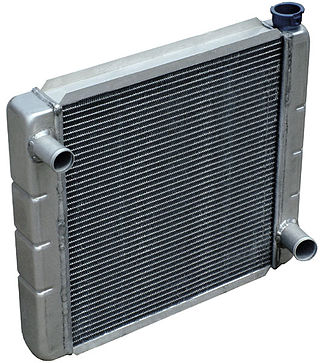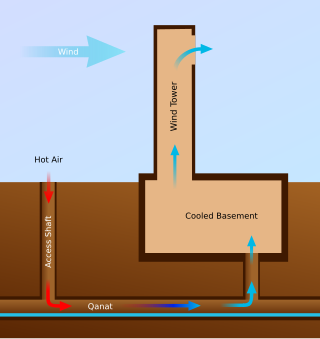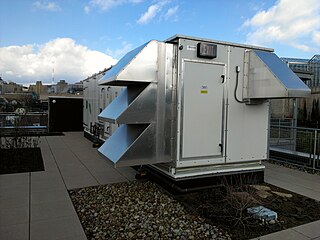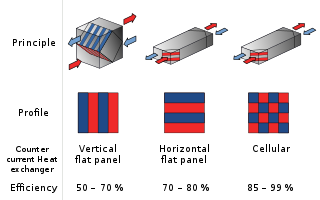
Heating, ventilation, and air conditioning (HVAC) is the use of various technologies to control the temperature, humidity, and purity of the air in an enclosed space. Its goal is to provide thermal comfort and acceptable indoor air quality. HVAC system design is a subdiscipline of mechanical engineering, based on the principles of thermodynamics, fluid mechanics, and heat transfer. "Refrigeration" is sometimes added to the field's abbreviation as HVAC&R or HVACR, or "ventilation" is dropped, as in HACR.

Radiators are heat exchangers used to transfer thermal energy from one medium to another for the purpose of cooling and heating. The majority of radiators are constructed to function in cars, buildings, and electronics.

A dehumidifier is an air conditioning device which reduces and maintains the level of humidity in the air. This is done usually for health or thermal comfort reasons, or to eliminate musty odor and to prevent the growth of mildew by extracting water from the air. It can be used for household, commercial, or industrial applications. Large dehumidifiers are used in commercial buildings such as indoor ice rinks and swimming pools, as well as manufacturing plants or storage warehouses. Typical air conditioning systems combine dehumidification with cooling, by operating cooling coils below the dewpoint and draining away the water that condenses.
Cooling is removal of heat, usually resulting in a lower temperature and/or phase change. Temperature lowering achieved by any other means may also be called cooling. The transfer of thermal energy may occur via thermal radiation, heat conduction or convection. Examples can be as simple as reducing temperature of a coffee.

A fan heater, also called a blow heater, is a heater that works by using a fan to pass air over a heat source. This heats up the air, which then leaves the heater, warming up the surrounding room. They can heat an enclosed space such as a room faster than a heater without fan, but like any fan, creates audible noise.

A ground-coupled heat exchanger is an underground heat exchanger that can capture heat from and/or dissipate heat to the ground. They use the Earth's near constant subterranean temperature to warm or cool air or other fluids for residential, agricultural or industrial uses. If building air is blown through the heat exchanger for heat recovery ventilation, they are called earth tubes.
Solar air conditioning, or "solar-powered air conditioning", refers to any air conditioning (cooling) system that uses solar power.

Energy recovery includes any technique or method of minimizing the input of energy to an overall system by the exchange of energy from one sub-system of the overall system with another. The energy can be in any form in either subsystem, but most energy recovery systems exchange thermal energy in either sensible or latent form.

Energy recovery ventilation (ERV) is the energy recovery process in residential and commercial HVAC systems that exchanges the energy contained in normally exhausted air of a building or conditioned space, using it to treat (precondition) the incoming outdoor ventilation air. The specific equipment involved may be called an Energy Recovery Ventilator, also abbreviated ERV.
Tadiran refers to a former Israeli conglomerate, which was founded in 1962 by the merger of two companies, Tadir and Ran. The name of the company is a joining of both companies’ names.
Free cooling is an economical method of using low external air temperatures to assist in chilling water, which can then be used for industrial processes, or air conditioning systems. The chilled water can either be used immediately or be stored for the short- or long-term. When outdoor temperatures are lower relative to indoor temperatures, this system utilizes the cool outdoor air as a free cooling source. In this manner, the system replaces the chiller in traditional air conditioning systems while achieving the same cooling result. Such systems can be made for single buildings or district cooling networks.
HVAC is a major sub discipline of mechanical engineering. The goal of HVAC design is to balance indoor environmental comfort with other factors such as installation cost, ease of maintenance, and energy efficiency. The discipline of HVAC includes a large number of specialized terms and acronyms, many of which are summarized in this glossary.

Solar air heating is a solar thermal technology in which the energy from the sun, insolation, is captured by an absorbing medium and used to heat air. Solar air heating is a renewable energy heating technology used to heat or condition air for buildings or process heat applications. It is typically the most cost-effective out of all the solar technologies, especially in commercial and industrial applications, and it addresses the largest usage of building energy in heating climates, which is space heating and industrial process heating.

Goodman Manufacturing is an American company operating as an independent subsidiary of Daikin Group, the world's largest manufacturer of heating, ventilation and air conditioning products and systems. The company, founded in 1975 and based in Waller, Texas, manufactures residential heating and cooling systems.
SPX Corporation is a supplier of highly engineered infrastructure equipment and technologies. The company operates within four markets: heating, ventilation, and air conditioning (HVAC), detection and measurement, power transmission and generation, and engineered solutions. Examples of SPX’s products include cooling towers and boilers, underground pipe and cable locators, power transformers, and heat exchangers. Brands include Waukesha, Dielectric, Fahrenheat, Radiodetection, and Pearpoint. SPX operates in 17 countries with a sales presence in 100 countries. In 2019, the company earned approximately $1.5 billion in annual revenue. Based in Charlotte, North Carolina, SPX employs over 6,000 employees. Eugene Joseph Lowe is the CEO.

A dedicated outdoor air system (DOAS) is a type of heating, ventilation and air-conditioning (HVAC) system that consists of two parallel systems: a dedicated system for delivering outdoor air ventilation that handles both the latent and sensible loads of conditioning the ventilation air, and a parallel system to handle the loads generated by indoor/process sources and those that pass through the building enclosure.
Trane Technologies is an Irish-domiciled holding company focused on the manufacturing of heating, ventilation, and air conditioning (HVAC) and refrigeration systems. The company traces its corporate history back more than 150 years and was created after a series of mergers and spin offs. In 2008, HVAC manufacturer Trane was acquired by Ingersoll Rand, a US industrial tools manufacturer. In 2020, the tools business was spun off as Ingersoll Rand and the remaining company was renamed Trane Technologies.

Mechanical, electrical and plumbing (MEP) refers to the installation of services which provide a comfortable space for the building occupants. In residential and commercial buildings, these elements are often designed by a specialized MEP engineering firms. The part of Mechanical in the overall MEP system is almost 70% of the total work. MEP's design is important for planning, decision-making, accurate documentation, performance- and cost-estimation, construction, and operating/maintaining the resulting facilities.
An inverter compressor is a gas compressor that is operated with an inverter.

A register is a grille with moving parts, capable of being opened and closed and the air flow directed, which is part of a building's heating, ventilation, and air conditioning (HVAC) system. The placement and size of registers is critical to HVAC efficiency. Register dampers are also important, and can serve a safety function.












